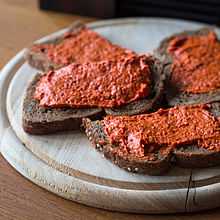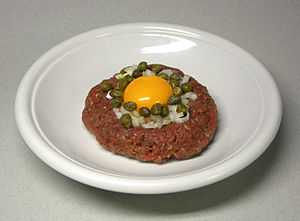Steak tartare
| Steak tartare | |
|---|---|
|
Steak tartare with raw egg, capers and onions | |
| Course | Appetizer |
| Main ingredients | Raw beef |
| Variations | Tartare aller-retour |
|
| |
Steak tartare is a meat dish made from finely chopped or minced raw beef.[1][2] It is often served with onions, capers and seasonings (the latter typically incorporating fresh ground pepper and Worcestershire sauce), sometimes with a raw egg yolk, and often on rye bread. The name tartare is sometimes generalized to other raw meat or fish dishes.
Although less common than the completely raw variety, there is a version served in France of steak tartare called tartare aller-retour. It is a mound of mostly raw steak tartare that is lightly seared on one side of the patty.
History
The name is a shortening of the original "à la tartare" or "served with tartar sauce," a dish popular in the 19th and early 20th centuries.[3][4]
The modern version of steak tartare with raw egg was first served in French restaurants early in the 20th century. What is now generally known as "steak tartare" was then called steack à l'Americaine. Steak tartare was a variation on that dish; the 1921 edition of Escoffier's Le Guide Culinaire defines it as steack à l'Americaine made without egg yolk, served with tartar sauce on the side.
Over time, the distinction between steack à l'Americaine and its variant disappeared. The 1938 edition of Larousse Gastronomique describes steak tartare as raw ground beef served with a raw egg yolk, without any mention of tartar sauce.
Although the word 'tartare' presumably refers to the Tatar or Tartar people of Central Asia, and there are many stories connecting steak tartare with them, steak tartare is not related to Tatar cuisine.[5]
"À la tartare" or simply "tartare" still means "served with tartar sauce" for some dishes, mostly fried fish.[6]
Health concerns
Health concerns have reduced the popularity of this meat dish in some parts of the world because of the danger of contamination by bacteria and parasites[7] such as Toxoplasma gondii and Taenia saginata.
Bacteria
When basic hygienic rules are followed and fresh meat is used, the risk of bacterial infection is low.[8] Even when these provisions are met, it is nonetheless not recommended for people who have a weakened immune system or suffer from a chronic illness, as these individuals are at a greater risk of infection from E. coli and/or Salmonella.
Parasites
Toxoplasma gondii is a parasite that may be found in raw or undercooked meat.[9] Cultural differences in raw meat consumption are thought to be a cause of regional variation in the prevalence of toxoplasma infection (ranging from around 55% in France down to 10% in the United Kingdom).[10] Due to the risk of congenital toxoplasmosis in the fetus, pregnant women are advised not to eat raw meat.[11] Latent toxoplasmosis in adults, though not as harmful as congenital toxoplasmosis, has been associated with psychological effects[12] and lower IQ[13] in some studies.
Regional variations

Africa
Ethiopian cuisine features a very spicy dish of prepared raw beef called kitfo.
Asia
Korean cuisine features a dish of prepared raw beef called yukhoe.
Northern Thailand features several dishes made with raw chopped or minced beef, but also pork, wild boar and even bear, collectively called "larb", a word originally from the northern Thai language meaning "to chop up finely".[14] Some of these northern Thai style larb dishes include the blood, bile and/or contents of the first stomach of cattle. These dishes are viewed as Thai salads due to the main ingredient being mixed with spices and herbs as in a salad.[15]
Europe

In Austria, it is called Beef tartare.
A variant of steak tartare called tartarmad is also present in Danish smørrebrød, where it is served on rugbrød (rye bread) with assorted toppings.
In Sweden, steak tartare is called Råbiff, and is usually served with raw egg yolk, raw onions, diced pickled beetroot and capers.
In Germany, there is a very popular variant using raw minced pork called Mett or Hackepeter, which is typically spread on rye bread or rolls.
North America
In Wisconsin it is quite popular among the descendants of German immigrants, though substituting raw ground sirloin for raw minced pork but still using rye bread as in Germany. It is popularly known as the "cannibal sandwich" among many Wisconsin residents.[16]
A Canadian version is to use bison meat.[17]
South America
Chilean cuisine features a dish of prepared raw beef called crudos.
In southern Brazil, influenced by German immigrants, it is known as Hackepeter or Carne de Onça in Curitiba where this dish is very common and served covered with chives.[18]
See also
- Basashi – Japan, horse meat
- Carpaccio – Italy, beef
- Çiğ köfte – Turkey
- Crudos – Chile
- Gored gored – Ethiopian
- Kibbeh nayyeh – Levant
- Kitfo – Ethiopia
- List of beef dishes
- Mett – Germany
- Salmon tartare
- Yukhoe – Korea
Bibliography
- Linda Stradley, I'll Have What They're Having: Legendary Local Cuisine, Falcon, 2002
- Craig J. Smith, The Raw Truth: Don't Blame the Mongols (or Their Horses), NY Times, 6 Apr 2005 [19]
- Raymond Sokolov, How to Cook, revised edition 2004, ISBN 0-06-008391-3, p. 41 at Google Books
- Albert Jack, What Caesar Did for My Salad: Not to Mention the Earl's Sandwich, Pavlova's Meringue and Other Curious Stories Behind Our Favourite Food, 2010, ISBN 1-84614-254-7, p. 141 at Google Books
References
| Wikibooks Cookbook has a recipe/module on |
- ↑ Waxman, Jonathan; Steele, Tom; Flay, Bobby; Kernick, John (2007). A Great American Cook: Recipes from the Home Kitchen of One of Our Most Influential Chefs. Houghton Mifflin Harcourt. ISBN 0-618-65852-1.
- ↑ Raymond Sokolov, The Cook's Canon, 2003, ISBN 0-06-008390-5, p. 183 at Google Books
- ↑ Sokolov, Raymond (2004). How to Cook Revised Edition: An Easy and Imaginative Guide for the Beginner. New York, NY (USA): Harper Collins. pp. 41–42. ISBN 0-06-008391-3. Retrieved 3 June 2012.
- ↑ Albert Jack, What Caesar Did for My Salad: Not to Mention the Earl's Sandwich, Pavlova's Meringue and Other Curious Stories Behind Our Favourite Food, 2010, ISBN 1-84614-254-7, p. 141 at Google Books
- ↑ Craig J. Smith (6 April 2005). "The Raw Truth: Don't Blame the Mongols (or Their Horses)". New York Times. Retrieved 3 June 2012.
- ↑ Prosper Montagné, Charlotte Snyder Turgeon, The new Larousse gastronomique: the encyclopedia of food, wine & cookery, 1977, p. 334
- ↑ "Fresh Meat for Steak Tartar". Streetdirectory.com. Retrieved 2013-12-14.
- ↑ http://whqlibdoc.who.int/publications/2009/9789241547895_eng.pdf
- ↑ "Toxoplasmosis | ANSES - Agence nationale de sécurité sanitaire de l’alimentation, de l’environnement et du travail". Anses.fr. Retrieved 2013-12-14.
- ↑ "Sources of toxoplasma infection in pregnant women: European multicentre case-control studyCommentary: Congenital toxoplasmosis—further thought for food". BMJ. Retrieved 2013-12-14.
- ↑ http://sogc.org/wp-content/uploads/2013/02/gui285CPG1301E-Toxoplasmosis.pdf?b2581b
- ↑ Dickerson, F.; Stallings, C.; Origoni, A.; Vaughan, C.; Katsafanas, E.; Khushalani, S.; Yolken, R. (2013). "Antibodies toToxoplasma gondiiin individuals with mania". Bipolar Disorders: n/a. doi:10.1111/bdi.12123. PMID 24102676.
- ↑ Flegr, J.; Preiss, M.; Klose, J.; Havlícek, J.; Vitáková, M.; Kodym, P. (2003). "Decreased level of psychobiological factor novelty seeking and lower intelligence in men latently infected with the protozoan parasite Toxoplasma gondii Dopamine, a missing link between schizophrenia and toxoplasmosis?". Biological psychology 63 (3): 253–268. doi:10.1016/S0301-0511(03)00075-9. PMID 12853170.
- ↑ http://shesimmers.com/2009/06/how-to-make-larb-gai-lahb-gai-laab-gai-larp-gai-laap-gai-lahb-gai-%E0%B8%A5%E0%B8%B2%E0%B8%9A%E0%B9%84%E0%B8%81%E0%B9%88.html source by author in the comments
- ↑ http://munchies.vice.com/articles/northern-thailands-raw-food-movement-involves-blood-and-guts/
- ↑ Statement by newscaster John Miernich on WTMJ-AM, Milwaukee, Wisconsin, December 31, 2014
- ↑ "Chianello: After the steak tartare alarm, Ottawa Public Health to develop guidelines". Ottawa Citizen. September 28, 2013. Retrieved December 4, 2013.
- ↑ http://g1.globo.com/pr/parana/noticia/2014/06/carne-de-onca-une-gastronomia-de-diversos-paises-no-mesmo-petisco.html
- ↑ Smith, Craig S. (2005-04-06). "The Raw Truth: Don't Blame the Mongols (or Their Horses)". The New York Times.
External links
| Wikimedia Commons has media related to Steak tartare. |
- Cooking.com recipe
- Stanford page on history of Mongols and their horses
- Cuisinenet glossary of terms
- BBC H2G2 page on the history of hamburgers
- Linda Stradley, What's Cooking America article on history and legend of hamburgers
- San Diego Union-Tribune article on steak tartare
- Metropolitan News Enterprise article on steak tartare
| |||||||||||||||||||||||||||||||||

.jpg)

